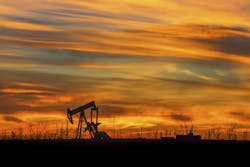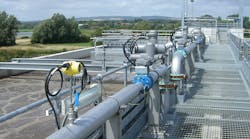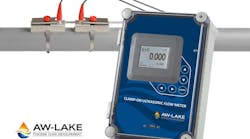Of available flow technology, what’s the best for petroleum-industry vent flare gas measurement? The flowmeter thus specified must measure flows ranging from one foot to 100 feet per second, without restricting flow, and all the while accommodate gas composition changes.
Many flow technologies work well under predictable process conditions, such as flare safety systems within industrial plants, but upstream vented flare gas can be challenging for those same technologies. It is the author’s contention that thermal mass flow technology is among the best for these type applications.
First, you may ask, does environmental regulation mandate that oil & gas exploration companies monitor and report daily volumes of flare and vent gas? Yes, it’s required both onshore or offshore, done either by calculation or direct measurement. And, given legitimate safety, environmental and security concerns, regulation will continue to expand.
In April 2012, the EPA issued rules, 40 CFR Part 98, Sub Part W, to address air emissions from all oil & gas exploration, production, processing, and transportation facilities. It says direct measurement of vented-gas flow must be done continuously. This ruling has impacted operators in the Marcellus and Utica shale in western Pennsylvania and upstate New York, the Eagle Ford in Texas, the Bakken formation in the Dakotas and others.
Oil & gas facts
When crude oil is extracted from shale formations, a considerable amount of natural gas is entrained, and this gas rises to the surface. A decade of North American shale oil & gas exploration and extraction has led regulators to clamp down on emissions, enforcing rulings to ensure compliance.
Flares seen in oil fields are burn-off from various sources. One is final-product vent gas from production tanks, sometimes referred to as tank batteries, which hold stable product for truck loading. The tanks are at atmosphere and venting allows product flow in and out. Vapor vented must be captured and burned. Given the potential for air to flow back into systems, it can’t be injected into the pipeline as re-pressurized gas.
High-pressure aspects of the production process lead to further flaring. As a crude oil, natural gas and water mix comes out of a well, pressures can range from 100 PSI to 5,000 PSI. Water and gas are separated from the crude oil, which is brought to atmospheric pressure and stabilized and the gas flows midstream for further processing.
The gas is pressurized, typically, and volatiles are driven off, but the gathering system infrastructure still requires a flare to burn off hydrocarbons rather than vent to atmosphere. A pipe feeds gas to the flare stack.
It may be necessary to flare gas during drilling, production or processing for several other reasons. When any shale well is drilled and fractured, a temporary flare for well-production testing monitors gas and oil pressure, flow and composition. Flaring lasts several days or weeks, as the well liquid and gas pressures and flows are stabilized.
In a well-site extraction, for a typical pad of six wells, each pad has a flare-stack pipe two inches to six inches in diameter. In the gas-extraction process, gas flaring at the stack must be moAs already mentioned, the best flare gas flowmeter choice measures an unrestricted flow traveling from one foot to 100 feet per second and accommodates changes in gas composition.
Flare line flows
The flare line gas can be of varying composition with hydrocarbons from C2 through C6. Composition can change based upon what happens at the extraction point. The gas flow is low under stable, normal conditions. Upset conditions can cause flow velocities to increase up to as much as 300 feet per second. This wide rangeability of flow, including pressure drops and varying gas compositions, can be a showstopper for most flow technologies.
One flow measurement method that performs reliably and accurately in vent flare gas applications is thermal mass technology, which operates on the constant-temperature differential method and provides a direct mass flow rate measurement, i.e., standard volumes without pressure/temperature compensation.
Of two RTD sensors, one measures temperature and the other senses flow. Changing gas temperature is corrected for and the flow-sensor temperature is set precisely above that of the passing media. Flow-measurement accuracy is based on the fact that any media will conduct heat off the sensor at a rate directly related to the mass flow rate.
Thermal mass technology has been around many years, and the last several years sensor design and electronics have improved measurably.
Given the various vent flare gas stream constituents, it’s important to have a probe that is of single-piece construction and easily maintained. Quick response to flow changes is essential to support normal velocities of two feet to eight feet per second and up to more than 100 feet per second during upset conditions.
When pressures drop
Another challenge involves pressure drops that occur as vent gas flows through the flare line. This variation can challenge flow technologies unless they are calibrated for upfront.
Vented flare gas monitoring technology must effectively respond to pressure changes or drops, and support turndown ratios up to 100-to-1. Thermal mass technology excels here. Further, thermal mass flowmeters present no flow-stream obstruction and accommodate virtually any line size. Thermal mass technology is easy to install using a process thread of ¾" NPT and, possibly, a hot-tap assembly. Either way, installation is quick and start-up and commissioning cost low.
A handful of flow technologies measure vent flare gas flows, including Pitot tubes, orifice plates with pressure transmitters, mechanical turbine style, thermal mass and a few others. Mechanical flowmeters, like turbines, have seals and bearings that can wear out over time. Further, if media flowing through the turbine section has any particulate matter, a turbine flowmeter can foul. The same is true for any meter having an entry point, such as an orifice plate, which can potentially clog.
At wellheads vent gas can be laden with sulfites and other flare-line particulates. A single-piece constructed probe body without openings or multiple sensor prongs is a huge benefit in dealing with fouling media.
Other technologies, final words
As a close of this article, it needs to be fully understood that flaring is a controlled burning of natural gas produced in association with oil in the course of routine oil and gas production operations. The purpose of venting is a controlled release of unburned gases directly into the atmosphere. The availability of a flare or a vent ensures that associated natural gas can be safely disposed of in emergency and shut-down situations. There are some newer methods in the oil and shale fields which can re-utilize this "exhaust" gas, but these methods are very costly, and sometimes technical unfeasible.
From a flow measurement perspective, there are some newer flowmeter technologies, like transit-time ultrasonic and Coriolis, which can perform well in vent & flare gas applications. However, their price point is typically higher than for thermal mass flowmeters. On the other hand, orifice plates with pressure transmitters and Pitot tubes can measure nominal or upset condition flows, but during the occasional upset condition, the wide dynamic flow range will prove difficult for these technologies to manage. In addition, gas mixture deposits can cause plugging problems with orifice plate and Pitot tube measurement device — especially with sulfites in the gas.
The use of thermal mass flow technology offers the end user on these applications the flexibility of a wide turndown ratio on the flow range, and can accommodate the variance in gas composition with a unique design. Whether the gas flare is a remote well site or a compressor station, the thermal mass design can be line powered (AC or DC) or it can be solar powered and wireless in its output. When one looks at the typical vent gas flare at a well head site, all flows are typically below velocities of 300 feet per second with the high end measurable by thermal mass meters and even ultrasonic flowmeters. However, many flares are specified based on worst-case scenarios that exceed this scale of measurement. Other flow technologies for vent flare gas applications may require multiple measurement techniques, increasing cost and often requiring more than one flare-line opening.
All things considered, this author believes thermal mass flow technology offers an optimal and economical solution for vent & flare gas measurement.
Jerry Boisvert is the sales and marketing director for Thermal Instrument Co. and has worked in level and flow instrumentation market for more than 30 years, including with Siemens, Emerson Process, Magnetrol, Flexim, and others. Reach Boisvert at 215 355-8400 or [email protected].
With more than a half-century of providing best-in-class flow measurement technology, Thermal Instrument Co. of Trevose, Pennsylvania, says it has solved just about every flow measurement challenge imaginable with it thermal mass flow metering technology.



